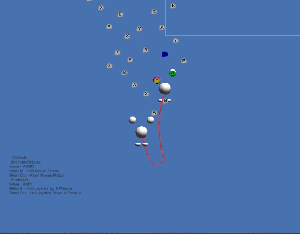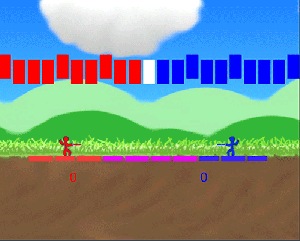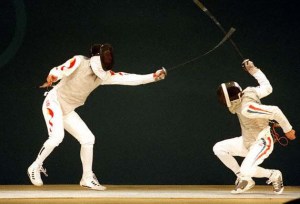We worked on Conversation Drawer for a period of three weeks. The prototype started off as a 1 week group prototype that employed a lead and follow mechanic as a metaphor to represent conversation. It was the first prototype that we decided to undertake as a group and it was pitched by Sam, building off of a handful of prototypes we had created over the summer and through the first couple weeks of the semester. At the end of the first week, we definitely had an interesting interaction, but it didn’t really convey the metaphor of conversation, in fact it was somewhat frustrating to play as it was difficult to catch up to the AI who was leading the conversation. A few of the other grads who play tested it for us mentioned it felt more like a game of tag than holding a conversation. The group decided to put some more time into the prototype to see if we could flesh out the experience and convey the central idea of a conversation. We chose to prototype two “conversations”: listening to a story and an intervention. This was to communicate different moods/types of conversation and see what that would look like in the context of our mechanic.
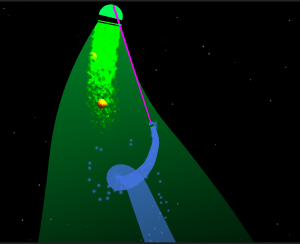
The player (blue) listening to a story from a story teller, from an a slightly earlier version.
What went well:
Working together felt really organic, which was great. It was good to get into the flow of making progress, meeting and reporting, making decisions and implementing ideas. At least for my part, I felt as though I could scaffold onto each group members’ work and incorporate their additions to the project into my own parts while still having a lot of ownership over the aspects of the project I was working on. I think the project generated many productive conversations around expectations of the final product going forward, particularly about the feel and aesthetic that we are trying to accomplish with out thesis work. We came to the consensus that we had to find a working balance between abstraction and metaphor on the one hand, and narrative, figurative elements and symbolism on the other. In other words: yes we want abstraction, but there must be enough in the way of semiotics there for people to grab onto and piece together a concept or pared-down narrative. It never felt like we got to a “stumped” point, which is a high possibility once we begin work on the final concept, and we continually had fun new discoveries and mechanisms to show off to each other, which kept spirits high. The last iteration definitely was starting to come together into a more defined aesthetic direction, and it was a fairly engaging experience. We were able to implement many of the game-play features we discussed and I think showing off the prototype to faculty yielded very useful feedback. One faculty member remarked that the interaction was fun, which while not our primary emotional target, is a welcome by-product. Another observed she felt “kinda sad” when one of the conversation partners took off without her. This is important as part of our research is focused on relatedness as a motivation in games, and its emotional ramifications.
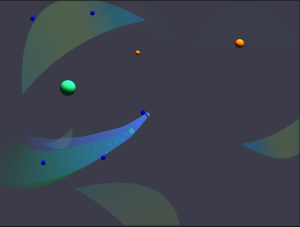
The player (blue) leading the green A.I. in conversation, guiding them to various “points” and “details”.
What didn’t go as planned:
Taking into account that this was only a three week prototype, one of the biggest problems at the end of the cycle is that it doesn’t seem like people were receiving the experience as a metaphor for conversation, which was part of the intention of the prototype. There is a distinct difference in expectation when people interact with a game as opposed to a piece of conceptual/contemporary art. With an art piece the audience often expects to spend time contemplating the symbols in the composition and come to a personal understanding and relationship with the work, which usually has no “correct” interpretation. This is of course different than religious or overtly propagandist genres of art. Interaction with video games does often include this personal relationship/interpretation aspect, but it is also expected that the game will explain itself/explain how to play it in some way. The challenge is to encourage the interactions we hope the player to experience, while not forcing the player’s hand, or being to heavy-handed and giving away the underlying metaphor. In any case, I think it is possible that that we can convey the metaphor given a lot more iteration and feedback.
That being said, the primary goals of out project do not overtly state conveying a metaphor, but rather hitting an emotional target other than fun, so we need to discuss how important this goal is to the final product. It is something that I am personally interested in; I think it is interesting when games play in that space between game/sport, interactive narrative and art piece. I observed that the faculty who tried our prototype seemed curious and engaged, however a few who got to the second part of the prototype (the intervention) were frustrated by the speed of their partners and the difficulty of catching up to them. Frustration is a target we should think about exploring, but it must be intentional. I think the game-play features were there, and they were interesting, but they didn’t exactly do what we wanted them to do, and so we should have put more effort into iterating that and making sure that component really worked. I think as a program that owes it’s lineage to CS, we have a distinct technologist bent, and we can get a little caught up in getting something to work. Don’t get me wrong, that is awesome and it feels really great when you get a feature/piece of tech up and running. I definitely have felt that way over the last few semesters. However, we need to be more aggressive about keeping sight of the core game-play first. It’s something I think we are improving on, and I in particular have a tendency to want to work on the aesthetic layer, but we really need to keep that in focus. For example, upon reflection the “drug points”, which the player would pick up and cause them to shoot a burst of particles for a short time, was very cool to look at, but may not have actually added to conveying the feel of an “intervention” style conversation.
Final Thoughts:
Overall I think it was a very good exercise. It’s the sort of thing I wish we had had more time to do last semester honestly. I would have much preferred working on one or two projects at a time for a period of a couple weeks to a month, as opposed to four or five semester long, large projects. I just didn’t feel like I had a handle on any of them. Anyway, I think Conversation Drawer is a strong contender for a final concept, but as Bryan pointed out, we should definitely have more prototypes under our belts before the end of next week so we have more options and expertise.
– Bob
